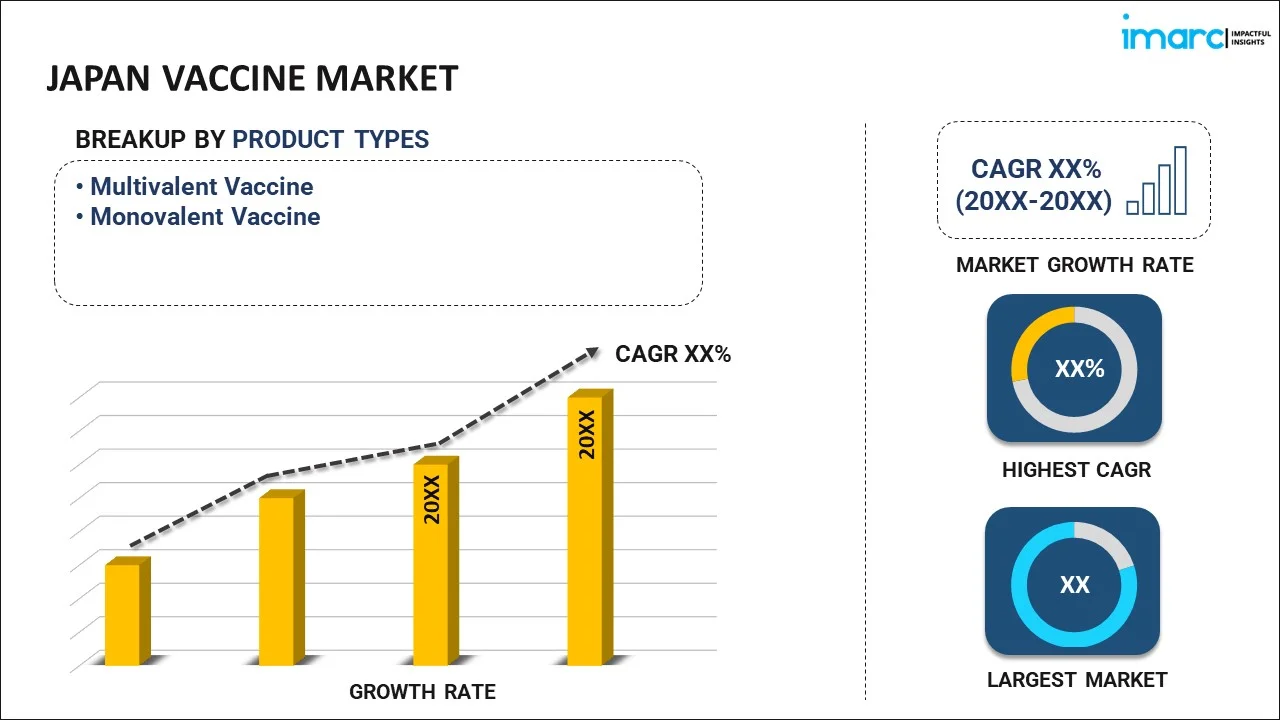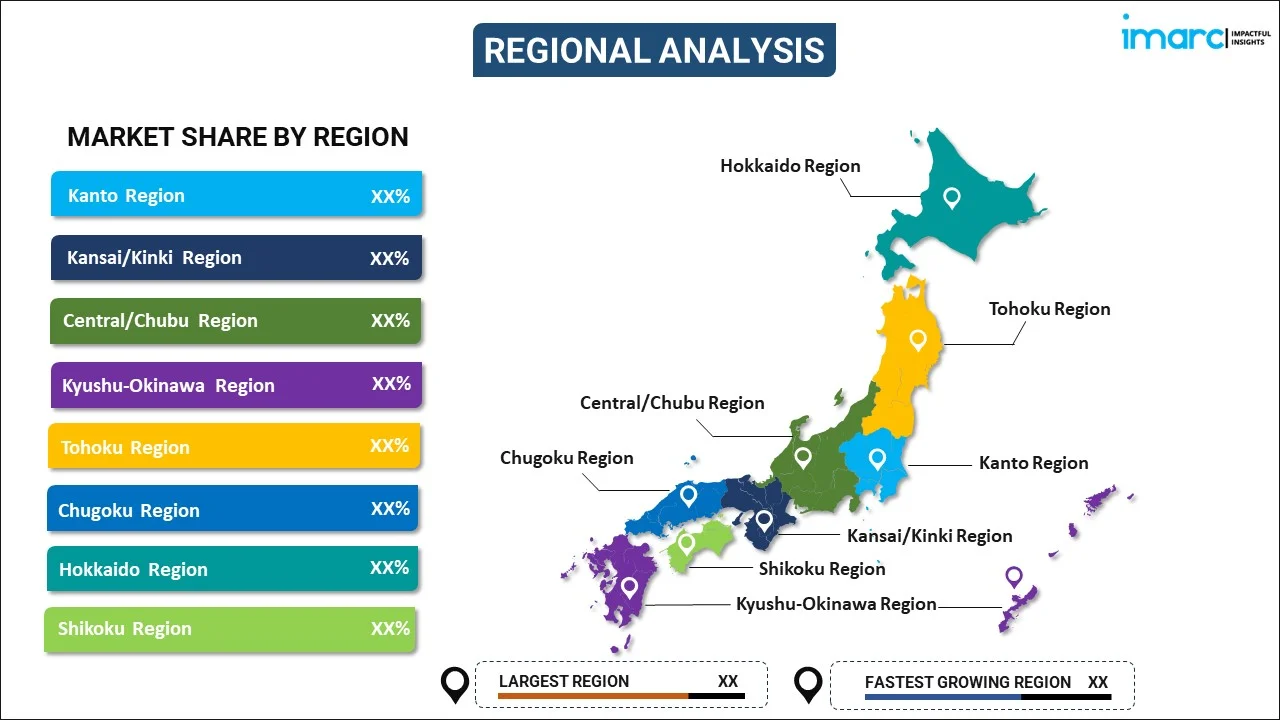
Japan Vaccine Market Report by Product Type (Multivalent Vaccine, Monovalent Vaccine), Treatment Type (Preventive Vaccine, Therapeutic Vaccine), Technology (Conjugate Vaccines, Inactivated and Subunit Vaccines, Live Attenuated Vaccines, Recombinant Vaccines, Toxoid Vaccines, and Others), Route of Administration (Intramuscular and Subcutaneous Administration, Oral Administration, and Others), Patient Type (Pediatric, Adult), Indication (Bacterial Diseases, Viral Diseases), Distribution Channel (Hospital Pharmacies, Retail Pharmacies, Institutional Sales, and Others), End User (Hospitals, Clinics, Vaccination Centers, Academic and Research Institutes, and Others), and Region 2025-2033
Market Overview:
Japan vaccine market size reached USD 3.0 Billion in 2024. Looking forward, IMARC Group expects the market to reach USD 3.9 Billion by 2033, exhibiting a growth rate (CAGR) of 2.88% during 2025-2033. The rising prevalence of several chronic diseases, increasing availability of extensive health insurance coverage, and the growing awareness among the masses about the importance of vaccination represent some of the key factors driving the market.
|
Report Attribute
|
Key Statistics
|
|---|---|
|
Base Year
|
2024 |
|
Forecast Years
|
2025-2033
|
|
Historical Years
|
2019-2024
|
| Market Size in 2024 | USD 3.0 Billion |
| Market Forecast in 2033 | USD 3.9 Billion |
| Market Growth Rate (2025-2033) | 2.88% |
A vaccine is a biological preparation that contains weakened or inactivated forms of pathogens or their components. It is administered to stimulate the immune system and provide immunity against specific diseases. It is rigorously tested for safety to ensure it does not pose significant risks to recipients. It is available in various forms, which include live attenuated, inactivated, subunit, mRNA, and viral vector vaccines. It requires strict temperature control during storage and transportation to maintain efficacy. It is highly effective in preventing a wide range of infectious diseases and often more cost-effective than treating the diseases. It is routinely administered to infants and children to protect them from diseases like measles, mumps, rubella, and pertussis.
Japan Vaccine Market Trends:
The expanding aging population in Japan represents one of the primary factors catalyzing the demand for vaccines to protect against age-related diseases. Additionally, the rising prevalence of several chronic diseases and the growing awareness among the masses about the importance of vaccination are offering a favorable market outlook in the country. Along with this, the country has a well-established distribution network that aids in ensuring vaccines reach the entire population. Apart from this, the increasing participation of Japan in vaccine diplomacy initiatives is bolstering its international standing and creating opportunities for vaccine manufacturers, enhancing production and exports. Furthermore, the expansion of pediatric vaccination programs with a focus on ensuring children receive recommended vaccines is strengthening the growth of the market. Moreover, continuous investments in research and development (R&D) efforts in the field of vaccines are stimulating the market growth. Along with this, rising collaborations with international organizations are facilitating access to a wide range of vaccines and contributing to market growth. Apart from this, the introduction of robust patient education campaigns is disseminating vital information about the benefits of vaccines, further improving acceptance rates. In addition, the availability of extensive health insurance coverage is ensuring the affordability of vaccines for the majority of the population. In addition, the emergence of Japan as a healthcare tourism destination is attracting visitors seeking healthcare services, including vaccinations. Furthermore, the robust epidemiological surveillance systems in Japan facilitate the identification of disease outbreaks and vaccination needs promptly, ensuring a swift response and heightened vaccine demand. Moreover, the expansion of domestic vaccine manufacturing capacity in Japan is ensuring a more self-reliant and resilient supply chain, reducing dependence on imports. Along with this, governing authorities of the country are implementing various incentives and streamlining regulatory processes to encourage vaccine development and manufacturing. These initiatives reduce the barriers to entry for vaccine manufacturers, fostering innovation and competition in the market.
Japan Vaccine Market Segmentation:
IMARC Group provides an analysis of the key trends in each segment of the market, along with forecasts at the country level for 2025-2033. Our report has categorized the market based on product type, treatment type, technology, route of administration, patient type, indication, distribution channel, and end user.
Product Type Insights:

- Multivalent Vaccine
- Monovalent Vaccine
The report has provided a detailed breakup and analysis of the market based on the product type. This includes multivalent vaccine and monovalent vaccine.
Treatment Type Insights:
- Preventive Vaccine
- Therapeutic Vaccine
A detailed breakup and analysis of the market based on the treatment type have also been provided in the report. This includes preventive vaccine and therapeutic vaccine.
Technology Insights:
- Conjugate Vaccines
- Inactivated and Subunit Vaccines
- Live Attenuated Vaccines
- Recombinant Vaccines
- Toxoid Vaccines
- Others
The report has provided a detailed breakup and analysis of the market based on the technology. This includes conjugate vaccines, inactivated and subunit vaccines, live attenuated vaccines, recombinant vaccines, toxoid vaccines, and others.
Route of Administration Insights:
- Intramuscular and Subcutaneous Administration
- Oral Administration
- Others
A detailed breakup and analysis of the market based on the route of administration have also been provided in the report. This includes intramuscular and subcutaneous administration, oral administration, and others.
Patient Type Insights:
- Pediatric
- Adult
The report has provided a detailed breakup and analysis of the market based on patient type. This includes pediatric and adult.
Indication Insights:
- Bacterial Diseases
- Meningococcal Disease
- Pneumococcal Disease
- Diphtheria/Tetanus/Pertussis (DPT)
- Tuberculosis
- Haemophilus Influenzae (Hib)
- Typhoid
- Others
- Viral Diseases
- Hepatitis
- Influenza
- Human Papillomavirus (HPV)
- Measles/Mumps/Rubella (MMR)
- Rotavirus
- Herpes Zoster
- Varicella
- Japanese Encephalitis
- Rubella
- Polio
- Rabies
- Dengue
- Others
A detailed breakup and analysis of the market based on the indication have also been provided in the report. This includes bacterial diseases (meningococcal disease, pneumococcal disease, diphtheria/tetanus/pertussis (DPT), tuberculosis, haemophilus influenzae (Hib), typhoid, others) and viral diseases (hepatitis, influenza, human papillomavirus (HPV), measles/mumps/rubella (MMR), rotavirus, herpes zoster, varicella, japanese encephalitis, rubella, polio, rabies, dengue, and others).
Distribution Channel Insights:
- Hospital Pharmacies
- Retail Pharmacies
- Institutional Sales
- Others
The report has provided a detailed breakup and analysis of the market based on distribution channel. This includes hospital pharmacies, retail pharmacies, institutional sales, and others.
End User Insights:
- Hospitals
- Clinics
- Vaccination Centers
- Academic and Research Institutes
- Others
A detailed breakup and analysis of the market based on the end user have also been provided in the report. This includes hospitals, clinics, vaccination centers, academic and research institutes, and others.
Regional Insights:

- Kanto Region
- Kansai/Kinki Region
- Central/ Chubu Region
- Kyushu-Okinawa Region
- Tohoku Region
- Chugoku Region
- Hokkaido Region
- Shikoku Region
The report has also provided a comprehensive analysis of all the major regional markets, which include Kanto Region, Kansai/Kinki Region, Central/ Chubu Region, Kyushu-Okinawa Region, Tohoku Region, Chugoku Region, Hokkaido Region, and Shikoku Region.
Competitive Landscape:
The market research report has also provided a comprehensive analysis of the competitive landscape. Competitive analysis such as market structure, key player positioning, top winning strategies, competitive dashboard, and company evaluation quadrant has been covered in the report. Also, detailed profiles of all major companies have been provided.
Japan Vaccine Market Report Coverage:
| Report Features | Details |
|---|---|
| Base Year of the Analysis | 2024 |
| Historical Period | 2019-2024 |
| Forecast Period | 2025-2033 |
| Units | Billion USD |
| Scope of the Report | Exploration of Historical Trends and Market Outlook, Industry Catalysts and Challenges, Segment-Wise Historical and Future Market Assessment:
|
| Product Types Covered | Multivalent Vaccine, Monovalent Vaccine |
| Treatment Types Covered | Preventive Vaccine, Therapeutic Vaccine |
| Technologies Covered | Conjugate Vaccines, Inactivated and Subunit Vaccines, Live Attenuated Vaccines, Recombinant Vaccines, Toxoid Vaccines, Others |
| Route of Administrations Covered | Intramuscular and Subcutaneous Administration, Oral Administration, Others |
| Patient Types Covered | Pediatric, Adult |
| Indications Covered |
|
| Distribution Channels Covered | Hospital Pharmacies, Retail Pharmacies, Institutional Sales, Others |
| End Users Covered | Hospitals, Clinics, Vaccination Centers, Academic and Research Institutes, Others |
| Regions Covered | Kanto Region, Kansai/Kinki Region, Central/ Chubu Region, Kyushu-Okinawa Region, Tohoku Region, Chugoku Region, Hokkaido Region, Shikoku Region |
| Customization Scope | 10% Free Customization |
| Post-Sale Analyst Support | 10-12 Weeks |
| Delivery Format | PDF and Excel through Email (We can also provide the editable version of the report in PPT/Word format on special request) |
Key Questions Answered in This Report:
- How has the Japan vaccine market performed so far and how will it perform in the coming years?
- What has been the impact of COVID-19 on the Japan vaccine market?
- What is the breakup of the Japan vaccine market on the basis of product type?
- What is the breakup of the Japan vaccine market on the basis of treatment type?
- What is the breakup of the Japan vaccine market on the basis of technology?
- What is the breakup of the Japan vaccine market on the basis of route of administration?
- What is the breakup of the Japan vaccine market on the basis of patient type?
- What is the breakup of the Japan vaccine market on the basis of indication?
- What is the breakup of the Japan vaccine market on the basis of distribution channel?
- What is the breakup of the Japan vaccine market on the basis of end user?
- What are the various stages in the value chain of the Japan vaccine market?
- What are the key driving factors and challenges in the Japan vaccine?
- What is the structure of the Japan vaccine market and who are the key players?
- What is the degree of competition in the Japan vaccine market?
Key Benefits for Stakeholders:
- IMARC’s industry report offers a comprehensive quantitative analysis of various market segments, historical and current market trends, market forecasts, and dynamics of the Japan vaccine market from 2019-2033.
- The research report provides the latest information on the market drivers, challenges, and opportunities in the Japan vaccine market.
- Porter's five forces analysis assist stakeholders in assessing the impact of new entrants, competitive rivalry, supplier power, buyer power, and the threat of substitution. It helps stakeholders to analyze the level of competition within the Japan vaccine industry and its attractiveness.
- Competitive landscape allows stakeholders to understand their competitive environment and provides an insight into the current positions of key players in the market.
Need more help?
- Speak to our experienced analysts for insights on the current market scenarios.
- Include additional segments and countries to customize the report as per your requirement.
- Gain an unparalleled competitive advantage in your domain by understanding how to utilize the report and positively impacting your operations and revenue.
- For further assistance, please connect with our analysts.
 Inquire Before Buying
Inquire Before Buying
 Speak to an Analyst
Speak to an Analyst
 Request Brochure
Request Brochure
 Request Customization
Request Customization




.webp)




.webp)












